24-5-2023 (KUALA LUMPUR) The Anwar Ibrahim administration has called upon the Employees Provident Fund (EPF), a state investment vehicle worth RM1 trillion (US$222.2 billion), to expand its domestic portfolio as part of efforts to stimulate the Malaysian economy. However, experts familiar with the matter have indicated that this transition is not a straightforward undertaking.
In 2021 and 2022, the administrations of Muhyiddin Yassin and Ismail Sabri Yaakob approved a series of withdrawals from the EPF to assist ordinary Malaysians in managing financial difficulties caused by the COVID-19 pandemic. These withdrawals have significantly altered the national savings landscape in a country with a rapidly aging population already grappling with challenges surrounding pension coverage.
Deputy Finance Minister Ahmad Maslan disclosed to parliament in February of this year that the median savings of EPF account holders had halved in 2022 compared to 2019, following the withdrawals. Highlighting the severity of the situation, Anwar Ibrahim, who has taken an unpopular stance against further withdrawals, recently stated that 81 percent of EPF’s approximately 15 million contributors will not have sufficient savings to sustain themselves above the poverty line upon retirement. He further revealed that only 19 percent of contributors manage to accumulate RM240,000 in personal financial reserves by the age of 55, the retirement age in Malaysia.
However, analysts and economists argue that the RM240,000 benchmark is no longer feasible given the substantial increase in the cost of living. This creates a significant challenge for individuals seeking to attain their basic savings target upon retirement.
On the opposite end of the spectrum, a mere 0.5 percent of EPF members, collectively holding 12.4 percent of the fund’s total savings at the end of 2020, have accumulated at least RM10 million each with the pension fund.
The EPF now faces the delicate task of balancing the need to stimulate the Malaysian economy while also addressing the concerns surrounding the eroded retirement savings of a large portion of its contributors. The complexity of the situation underscores the multifaceted nature of reforming the EPF’s domestic portfolio.




